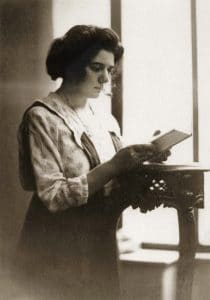Een jeugd waarin niets gebeurt en die even desolaat als eenzaam is. Je zou denken dat dat nauwelijks stof voor een boek oplevert, maar Dolores Prato (1892-1983) bewees het tegendeel. Haar autobiografische roman Daar op het plein is niemand, grofweg 800 pagina’s dik, werd ruim veertig jaar geleden in een zeer sterk verkorte versie uitgegeven. Prato, toen al hoogbejaard, was niet blij met die redactionele ingreep. Maar het duurde tot ver na haar dood voordat de volledige versie alsnog het levenslicht zag, nu uitstekend in het Nederlands vertaald door Jan van der Haar.
Nonkeltje
Prato groeide op bij haar oom en tante – broer en zus – in het Italiaanse plaatsje Treja (Treia) in de Marken. Haar moeder, een losbandige vrouw over wier ‘euveldadenbrochure’ flink in het dorp wordt geroddeld, brengt haar onwettige dochtertje niet lang na haar geboorte onder bij deze oom en tante. De vrolijke pastoor (‘Nonkeltje’) en zijn dierbare zuster met een boezem als een ‘altaartje zonder kruis en zonder kandelaars’, bedoelen het niet slecht, maar zijn totaal ongeschikt als ouders. ‘Ik woonde afgezonderd bij twee bejaarden die zich niet aan mijn jeugd konden aanpassen.’

Geknuffeld of gekust wordt de kleine Dolores nooit; de enige keer dat haar tante haar op schoot neemt, is als ze haar neus heeft verbrijzeld bij een valpartij. Haar leven is eenzaam en kaal en vriendjes of vriendinnetjes zijn er tijdens haar lagereschooltijd ook nauwelijks. Een warme herinnering koestert ze alleen aan Ernesta, de ‘foute’ vriendin van een andere oom die met haar lacht en een soort ‘hop paardje hop’ speelt: ‘de enige losgeslagen pret van mijn kindertijd’. Veelzeggend is het dan ook hoe Dolores het kinderrijmpje dat ze zingen aanvult: ‘Maagdekijn, marsepein, daar op het plein… is niemand.’ Au.
Pointillistisch schilderij
Mede door die eenzaamheid leert ze het leven, de anderen, zo goed te observeren. Want kijken en luisteren kan Dolores Prato maar al te goed. ‘Ik weet dat ik nooit een geheugen heb gehad’, schrijft ze, ‘wat een geheugen lijkt is een verzameling littekens, of een album met gravures.’ Maar dit minutieuze autobiografische verslag is vergelijkbaar met een pointillistisch schilderij: alle punten, alle kleine details, vormen samen een schilderij van enkele jaren uit een kindertijd.
Als een kolibrievlinder fladdert ze van de ene scène naar de andere, van het ene onderwerp naar het andere. Van oudjaar en de jaarmarkten voert ze de lezer mee naar carnaval en Pasen, van het ene seizoen naar het andere, langs streekgerechten en benamingen, gebruiken en opvattingen, terwijl ondertussen een bonte stoet van dorpsgenoten en familieleden de revue passeert – we leren het dorp en Dolores kennen tot in de kleinste details.
Het ogenschijnlijke gemak waarmee Prato dat doet, de metaforen die ze daarbij gebruikt en de vaak omfloerste, geestige (en soms ook ontroerende) beschrijvingen die haar roman ook een zekere lichtheid meegeven, verraden een groot literair talent. In ruil daarvoor eist Prato iets terug van haar lezer; te midden van het plotgedreven literaire landschap van dit moment vergt een boek van achthonderd pagina’s meanderend proza overgave en concentratie. Maar wie zich door Daar op het plein is niemand laat meevoeren, wordt beloond met een bijzondere leeservaring.
Dolores Prato, Daar op het plein is niemand. Vertaald door Jan van der Haar.
De Arbeiderspers, 829 p., € 45,00
